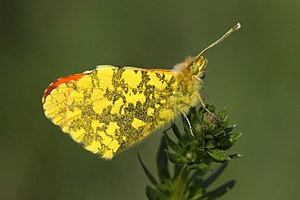Eastern aurora butterfly
| Eastern aurora butterfly | ||||||||||||
|---|---|---|---|---|---|---|---|---|---|---|---|---|

Eastern aurora butterfly ( Anthocharis damone ) ♂ |
||||||||||||
| Systematics | ||||||||||||
|
||||||||||||
| Scientific name | ||||||||||||
| Anthocharis damone | ||||||||||||
| Boisduval , 1836 |
The eastern aurora butterfly ( Anthocharis damone ) is a butterfly (day butterfly ) from the family of white flies (Pieridae). The specific epithet is derived from Damone, one of the fifty daughters of Danaos from Greek mythology .
features
The males are colored sulfur yellow on the upper side of the wing and have orange wing tips on the front wings. These are framed by the black discoid spot and dark scales. The underside of the hind wing is also yellow and has a pattern of gray-green scales similar to that of the aurora butterfly ( Anthocharis cardamines ). The underside of the forewing is lighter yellow with a black discoid, an orange post-disc area and a yellow apex. The Eastern Orange Tip has a pronounced sexual dimorphism . In contrast to the males, the females are colored white on the upper side of the wings. The underside of the hind wing is drawn exactly like that of the males and often shines through on the upper side. The underside of the forewing is also white with a black discoid and a yellow apex. Male moths of the eastern aurora moth can only be confused with Anthocharis gruneri in their area of distribution . In Anthocharis gruneri, however , the basic color of the upper side of the wing is much lighter yellow and the basic color of the lower side of the rear wing is white, not yellow. The females of the eastern aurora butterfly are also similar to those of Anthocharis gruneri , but also have a yellow underside of the hind wing, so that both males and females can be clearly distinguished from the other species. Due to the pattern of the drawing, there is a resemblance to the aurora butterfly ( Anthocharis cardamines ), especially in the female , but this can also be easily distinguished by the striking yellow color of the underside.
Similar species
- Anthocharis gruneri
- Aurora butterfly ( Anthocharis cardamines )
Subspecies
Anthocharis damone damone (Boisduval, 1838)
Only includes the population in Italy . The type location is Sicily.
Anthocharis damone eunomia (Freyer, 1851)
Covers all populations east of Italy, i.e. Macedonia , Greece , Turkey (with the exception of northern and central areas), Armenia , Azerbaijan , Georgia , Syria , Lebanon , northeast Iraq , western Iran and Israel . Type location is Turkey.
Occurrence and habitat
The eastern aurora butterfly is very poorly distributed, especially in Europe, and is limited to low to medium altitudes of mountains. The western limit of distribution is in southern Italy. Some mountain regions in Calabria and eastern Sicily are populated there, such as Mount Etna . The occurrences in Macedonia and Greece are similarly limited to mountains . In Asia, the species flies in a strip on the south coast of Turkey and in large parts of eastern Turkey. From Turkey south it occurs to Israel and east to Transcaucasia and western Iran. The eastern aurora butterfly flies at altitudes of 350–1300 m, in eastern Turkey also up to 3300 m. The habitat is made up of gaps, overgrown to stony, south-facing, often steep slopes with limestone soil. As well as valleys rich in vegetation with flowering meadows and open, sparse forests.
Way of life
The flight time begins in lower and south-exposed locations as early as mid-March, but mostly at the beginning of April and lasts until the end of May. In the higher elevations of the distribution area, the end of the flight season can be delayed until July or the beginning of August. Serves as the main food plant woad ( Isatis tinctoria ). The moths usually lay the eggs individually or in small groups on the flower buds. The caterpillars feed on the inflorescences and the ripening, young seed pods. Pupation takes place on dry plant stems, not infrequently that of the forage plant itself.
Individual evidence
- ^ Arnold Spuler: The butterflies of Europe . tape 1 . E. Schweitzerbartsche Verlagbuchhandlung, Stuttgart 1908, p. 8 .
- ^ A b c d Tom Tolman, Richard Lewington: Collins Butterfly Guide - The Most Complete Field Guide to the Butterflies of Britain and Europe . Harper Collins, 2008, ISBN 978-0-00-727977-7 , pp. 62 .
- ↑ a b c Anthocharis damone. Lepiforum, accessed January 11, 2018 .
- ↑ a b c Vadim Tshikolovets: Butterflies of Europe and the Mediterranean area . 2011, ISBN 978-80-904900-0-0 .
Web links
- Anthocharis damone at Fauna Europaea
- Anthocharis damone in the Lepiforum
- Anthocharis damone in the Catalog of Life

